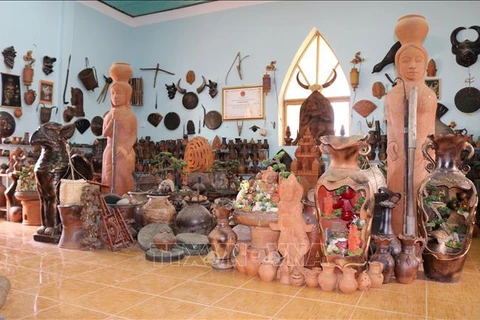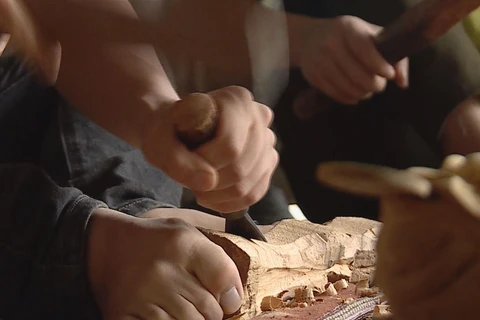 Currently, Hanoi has 1,350 traditional craft villages, accounting for 45 percent of the total number of trade villages in the country. (Photo: VNA)
Currently, Hanoi has 1,350 traditional craft villages, accounting for 45 percent of the total number of trade villages in the country. (Photo: VNA) Hanoi (VNS/VNA) - Handicraft products made by craft villages in Hanoi are currently very similar in design, impacting competitiveness.
To solve this problem, Hanoi’s Department of Industry and Trade has cooperated with domestic and foreign experts to provide advice and support to artisans and businesses to improve design quality as well as promote creativity ideas to have valuable products and meet the needs of customers.
Hanoi has 1,350 traditional craft villages, accounting for 45 percent of the total number of trade villages in the country. However, most businesses, production facilities and craft villages are not aware of the importance of building a brand.
The main reason is that the craft villages are mainly small and fragmented operations which lack cohesion, making it difficult to access capital as well as lacking resources and methodical training on brand management and professional design.
Design is the soul of the product, handicrafts, as well as fashion, need new patterns constantly. Good design creates good business, according to Claire Driscoll, an expert in handicraft product design at the British Council.
According to Nguyen Thanh Hai, Deputy Director of Hanoi’s Department of Industry and Trade, craft villages in Vietnam are very weak in designing handicraft samples. Therefore, the department has cooperated with local and foreign design experts to advise and share experiences with artisans and businesses in this field.
Thereby, the design experts help artisans and businesses promote creative ideas to make new products with high economic, technical and artistic value suitable to customers’ tastes. This is a premise for businesses to promote the development of new product designs to serve market needs.
Hai also emphasised that Hanoi is the leading region in handicraft sector. Particularly in 2018, the export turnover of handicrafts reached 192 million USD, attracting nearly one million workers with an average income of about 55 million VND (2,367 USD) per person per year.
In addition to the achieved results, Hanoi's handicraft industry has not yet fully developed its potential and strengths. Products have not met the needs of the market yet, especially the export market, the competitiveness of the product is still weak compared to similar products of other countries in the region such as China, India and the Philippines.
Nguyen Anh Hieu, a representative of the Chuc Son Rattan Bamboo Export Company Limited, said the products of traditional craft villages are mainly based on traditional models or foreign models brought by customers. Most businesses are still passive in finding, creating and designing products.
Economic experts say that there are many causes for this, including slow innovations of models, products that are not creative, many products have not yet originated from the needs of customers, most of them moulded according to the models available on the market or orders from customers.
Many good artisans have beautiful designs but lack commerciality and are difficult to mass produce.
Regarding this weakness, Luu Duy Dan, Chairman of the Vietnam Association of Craft Villages, said this was the general situation of handicraft production establishments, especially small-scale establishments, in our country.
Due to limited resources, these facilities did not dare invest in a dedicated design team, lacked conditions to research and understand the tastes of international consumers.
Meanwhile, many facilities were also afraid that if they invest in basic designs, they would be counterfeited after a short time due to Vietnam’s loose protection of intellectual property rights. Therefore, enterprises and manufacturing facilities need the support of departments and agencies in improving and creating product designs.
Ha Thi Vinh, Chairwoman of the Hanoi Handicraft and Craft Villages Association, said compared with other countries in the region such as Thailand and Indonesia, Vietnamese handicrafts were less competitive in design.
In order to boost the export of handicrafts, traditional craft villages needed to change by innovating designs to meet consumer tastes, while retaining the traditional identity and values of the products, Vinh suggested. - VNS/VNA
VNA






















